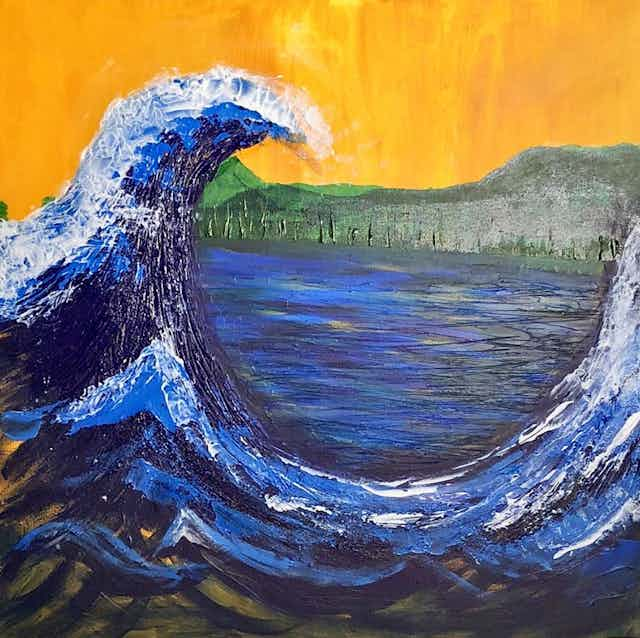Exactly How Trump Art Shows Modern Political Satire in the Painting Globe
Getting Started on an Aesthetic Trip Through the Lyrical Interpretations of Nature in Stylist Landscapes
Each brushstroke, each play of light and shadow, and each shade option in their works talks volumes concerning the musicians' deep connection to nature and their capacity to equate its beauty onto the canvas. As we check out the lyrical interpretations of nature in Stylist landscapes, we are invited to submerse ourselves in a world where fact and feeling intertwine, supplying a look into the musicians' profound recognition for the natural globe.
The Captivating Brushstrokes of Claude Monet
Claude Monet's proficiency of brushstrokes transcends plain technique, imbuing his landscapes with an angelic top quality that enthralls and captivates customers - trump art. His innovative use shade and light, combined with his distinctive brushwork, produces a sense of motion and life within his paints. Monet's distinguished series of works showing water lilies and his renowned haystacks display his ability to catch the short lived effects of light and ambience

Taking On Light and Darkness With Camille Pissarro
Symbolizing a comparable reverence for the interaction of light and darkness, Camille Pissarro's artistic vision unravels as a harmonious exploration of the environment's luminous nuances. Pissarro, a crucial figure in the Impressionist activity, masterfully recorded the dynamic partnership in between light and shadow in his landscapes. His adept usage of shade and brushwork allowed him to communicate the refined changes in light that define different times of day and seasons.
Pissarro's paints frequently include spotted sunshine infiltrating leaves, casting complex patterns of light and darkness on the planet below. In works such as "Hoar Frost, the Impact of Snow, Pontoise," Pissarro skillfully illustrates the crisp illumination of winter sunlight juxtaposed with the great darkness that specify the snowy landscape. By embracing both light and shadow in his compositions, Pissarro invites audiences to immerse themselves in the natural appeal and short-term results of light on the planet around them.

With Pissarro's works, we are reminded of the transformative power of light and shadow, inviting us to stop and value the short lived minutes of elegance existing in the day-to-day landscapes that border us.
A Harmony of Colors by Edgar Degas
Edgar Degas manages a lively harmony of colors in his masterful artworks, infusing his compositions with a dynamic interaction of tones that astound the visitor's stare. Recognized mostly for his ballet professional dancers and intimate scenes of Parisian life, Degas skillfully manipulated colors to convey state of mind and activity in his paints. trump art. His use bold, contrasting shades and refined tonal variants developed a feeling of deepness and vibrancy within his works
Degas' color palette frequently consisted of rich blues, deep greens, and warm oranges, which he applied with positive brushstrokes to capture the essence of his subjects. Whether portraying a ballerina mid-performance or a group of friends conversing at a cafe, Degas' colors not just illustrated the scene yet also stimulated a sense of feeling and energy.
Additionally, Degas' trial and error with light and shadow added an extra layer of complexity to his shade make-ups, enhancing the general ambience of his paintings (trump art). Via his skillful adjustment of color, Degas developed a visual harmony that remains to resonate with customers today
Discovering Nature's Tranquility With Berthe Morisot
Berthe Morisot's creative vision supplies a peaceful separation from the dynamic shade symphonies of Edgar Degas, as she records the serenity of nature in her expressive landscapes. Known for her fragile brushwork and you could try these out intimate representations of daily life, Morisot's landscapes exude a feeling of peace and consistency.
Morisot's paintings usually include soft, soft tones that convey a feeling of calmness and serenity. Her jobs, such as "The Cradle" and "Summertime's Day," display her capability to capture the subtle charm of nature in a method that is both contemplative and soothing to the customer.
Unlike several of her Impressionist equivalents who concentrated on vibrant structures and bold shades, Morisot preferred to produce mild, introspective scenes that welcome the audience to stop and mirror. Through her skillful use of light and darkness, Morisot creates a feeling of harmony that resonates with the viewer on a deep psychological level.
The Psychological Landscapes of Vincent Van Gogh
Vincent Van Gogh's landscapes vividly communicate a deepness of emotion via their dynamic brushwork and expressive use color. The Dutch post-impressionist musician is renowned for his ability to capture extreme and raw feelings in his paints, going beyond traditional representations of nature. Van Gogh's tumultuous personal life, marked by psychological wellness struggles, considerably affected his art, instilling his landscapes with a sense of anxiousness, sorrowful, or exuberance.
In works such as "Starry Night" and "Wheatfield with Crows," Van Gogh's swirling brushstrokes and dynamic shade choices stimulate an extensive psychological feedback from visitors. The stormy skies and flustered landscapes in his paints show his inner turmoil and psychological disturbance, inviting audiences to look into the intricacies of his subconscious.
Van Gogh's one-of-a-kind aesthetic language, defined by exaggerated perspectives and vibrant usage of color, creates landscapes that resonate with hop over to these guys visitors on a deeply psychological level. Through his art, Van Gogh welcomes us to see nature not simply as an outside reality but as a mirror of our innermost sensations and feelings.
Final Thought
To conclude, the impressionist landscapes of artists such as Claude Monet, Camille Pissarro, Edgar Degas, Berthe Morisot, and Vincent Van Gogh offer a one-of-a-kind and fascinating aesthetic analysis of nature. Through their use brushstrokes, emotion, shade, and light, these artists have actually produced a harmony of pictures that evoke a feeling of calmness and charm in the all-natural globe. Their works proceed to influence and enchant viewers with their lyrical analyses of the landscapes around us.
Each brushstroke, each play of light and darkness, and each color selection in their jobs speaks quantities about the musicians' deep link to nature and their capability to equate its charm onto the canvas. His innovative usage of color and light, incorporated with his distinctive brushwork, develops a feeling of movement and life within his paints. His proficient use of color and brushwork allowed him to communicate the subtle shifts in light that specify various times of day and seasons.
